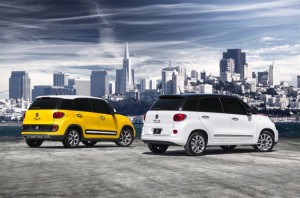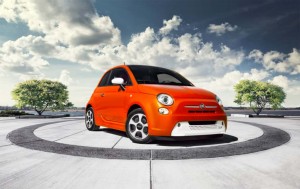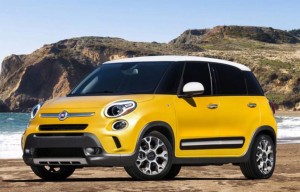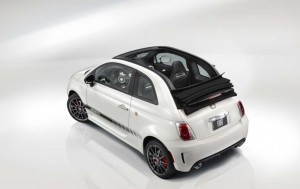Fiat officials like to point out that it took years for their closest competitor, Mini, to expand its vehicle line-up and firmly establish itself in the American market. After a painfully slow start, the Italian maker is kicking its product program into high gear and hopes sales will quickly keep pace.
This week’s LA Auto Show will, in fact, see the debut of four new Fiat models and model variants large and small. Well, make that small, and not quite so small, as the maker plans to stick with the mini- and microcar segments.
“We’re launching some significant things in California,” promises Fiat’s U.S. brand boss Tim Kuniskis, vehicles which could be especially important in the Sunshine State market – currently Fiat’s largest, representing nearly one of every eight products it sells in the U.S.

Despite the bigger interior and larger exterior dimensions, the Fiat 500L still fits in the B-car segment.
We already got at least a bit of a peak at one of the new offerings earlier this year, Fiat rolling out the European version of the 500L at the Geneva Motor Show last spring. But now we get a closer look at the American version, and there are some distinct differences worthy of noting.
But first, some basics: the 500L is 24 inches longer and 6 inches wider than the current 500 Coupe. It sits about 6 inches higher, and it is roomy enough inside – with 120 cubic feet of interior space, 42% more than the Fiat 500 – to be classified a large car by EPA rules, even though it fits into the footprint of a B-segment car.
There’s enough room to fit five, and without making the three in the back seat feel like they’re riding in a packed regional jet coach seat. There’s also plenty of headroom, front and back, even for five tall Americans.
That’s critical for future growth, according to Kuniskis, because Fiat has determined “There are a lot of people who want to come to the Fiat brand but just need more space.”

Expect an EPA range of around 80 miles with the Fiat 500e, though the maker expects closer to 100 in stop-and-go driving.
The layout, according to program members, was meant to give the 500 L a “loft feel,” comfortable and a bit Euro-chic. The windshield was brought more forward than with the 500 and the wraparound glass design translates into what Fiat claims to be best-in-class visibility. And the wraparound headlamps give the new model a distinct visual personality that doesn’t look like a clone of other small crossovers.
Functionally, the U.S. version of the 500L is all but identical to what first appeared in Geneva, the overall design theme described as squares-and-circles. But for the States, there are unique front and rear fascias – in part to handle different crash standards – as well as side moldings that are body colored. Fiat research revealed that while the original, contrasting inserts were seen as expensive by European motorists they came across as cheap to Americans.
The U.S. version of the 2013 Fiat 500L will be powered by the same 1.4-liter MultiAir engine offered in the current 500, here making 160 horsepower and 184 lb-ft of torque. That power can be channeled through either a six-speed manual or a double-clutch transmission.
Imported from a new Fiat manufacturing facility in Serbia, expect to see the 500L reach showrooms by next spring. And don’t be surprised, insiders hint to TheDetroitBureau.com, if some additional variants follow in short order.
We’re certainly seeing that with the 500, the original Coupe being followed by a 500C Convertible, then the Abarth performance edition – and now the Abarth Convertible.
The other model likely to make a big splash in Los Angeles is the Fiat 500e, the first electric vehicle for Fiat/Chrysler.
We’ve already covered the new battery-electric minicar in some detail, and you can check out our most recent story by Clicking Here. But here are some basics.
The Fiat 500e will pack in 24 kilowatt-hours of lithium-ion batteries. The maker expects to get 80 miles per charge until routine driving and as much as 100 in urban stop-and-go conditions. That is expected to work out to as much as 116 MPGe when the EPA delivers its formal rating.
To get there, Fiat engineers had plenty of work, and much of their effort focused on aerodynamics, which reportedly have been improved by about 13% compared to the gas-powered Fiat 500. Credit such body tweaks as the “dot matrix” front fascia, sealed underbody, larger rear spoiler and 15-inch wheels with flush faces.
The electric drivetrain makes 111 horsepower and 147 lb-ft of torque and, as typical with electric motors, power comes on fast so you’ll get to 60 a couple seconds faster than the standard Fiat 500.
The battery pack can be recharged in about four hours using a 240-volt system, though at 120 volts it will take the better part of a day. The Fiat 500e is ready should you have access, meanwhile, to a 480-volt Level III quick-charge system.
The high-tech system includes an infotainment system that will access numerous smartphone apps. There’s also a remote app to remotely control charging. And the in-dash navigation system can help you find the best route to maximize battery power – and then find a nearby charging station if you need one.
The show car comes in Electrico Arancione – Electric Orange, if you prefer.
Initial sales are expected to be modest and largely focus on California. It’s not only the state where battery-car sales are strongest but regulators are also requiring major automakers to start marketing so-called zero-emission vehicles, or ZEVs, over the next several years.
While Fiat officials like Kuniskis seem pleased to add the 500e, there’s less support from the top. Fiat/Chrysler CEO Sergio Marchionne has made it clear he’d likely not have the battery-car in the line-up if it weren’t for those pesky California mandates. As with other makers, Fiat expects to continue losing money on every electric vehicle it sells in the near to mid-term future, prompting Marchionne to dub vehicles like the 500e, “economic lemons.”
Also on tap in LA, Fiat will reveal its second convertible, this one based on the high-performance Abarth model. As with the Abarth Coupe, the cabriolet will make 155 horsepower out of the 1.4-liter MultiAir engine – though that kicks up to 160 in Sport Mode – and 170 lb-ft of torque.
The numbers that could be particularly appealing, however: you can roll the soft-top back halfway at speeds up to 60 mph, and put it down entirely at up to 50.
Compared to the plain vanilla Fiat 500C, the Abarth Convertible gets stiffer springs and other suspension upgrades, larger half-shafts and CV joints, a quicker steering rack and upgraded brakes – as well as 17-inch wheels. There are also three stability control modes.
The Abarth Convertible will be the first car on the road offered with an optional Beats by Dr. Dre sound system, incidentally.
And as with the Abarth Coupe, the package includes free driving lessons at the Richard Petty Driving Experience.
To wrap things up, Fiat is also bringing to LA the 500 Trekking Model. The modified coupe gets unique fascias, including larger front air intakes, finished in satin chrome.
Expect to see even more of these packages in the future.



“The U.S. version of the 2013 Fiat 500L will be powered by the same 1.4-liter MultiAir engine offered in the current 500, here making 160 horsepower and 184 lb-ft of torque. That power can be channeled through either a six-speed manual or a double-clutch transmission”
It is not the best engine of FIAT.
It was born before the advent of the MultiAir technology.
FIAT replaced the conventional cylinder-head (the original cylinder head) with its DIGITAL innovation,
i.e. the DIGITALLY controlled Variable-Valve-Actuated cylinder-head
invented by FIAT
and being built by Schaeffler-INA in Germany.
Later on (after the invention of the MultiAir Tech)
FIAT designed the TwinAir engine,
a new Twin-cylinder block (new pistons, valves etc)
and Schaeffler-INA builds the cylinder-head of the TwinAir engine.
Despite the only two cylinders, the performance of the TwinAir
(if installed in the same car, e.g. the Alfa Romeo Mito or the FIAT 500)
and especially the MILEAGE,
is so DIFFERENT that FIAT sells the Alfa Romeo Mito with the 4-cylinder MultiAir cheaper than the same car with the Two-Cylinder TwinAir engine.
Still, it takes only PURE mathematics
To see
That even the Twin-Air engine (the best-engine-of-the-year 2011) can DOUBLE its MILEAGE,
THANKS to the POTENTIAL of its DIGITAL technology,
(its UNIQUE Digital Tech):
http://www.pattakon.com/pattakonHydro.htm
May I quote?
“TheDetroitBureau.com | The Voice of the Automotive World ”
Does it mean that the mistakes, faults, errors, blunders of the “Automotive World”
Must not have a “Voice” ?
Either the Group of the FIAT AND Chrysler AND -…-AND-Ferrari is that BIG to have done such a Scientific and Engineering Blunder
Or I am mathematically wrong and lying about the prototypes:
http://www.pattakon.com/pattakonHydro.htm
IF ALL it takes is PURE mathematics
Would it be better to ask an expert or a STUDENT of THERMODYNAMICS?
OUT of PURE curiosity?????
If I am wrong nobody gets hurt
If I am right the whole world is hurting, or not?